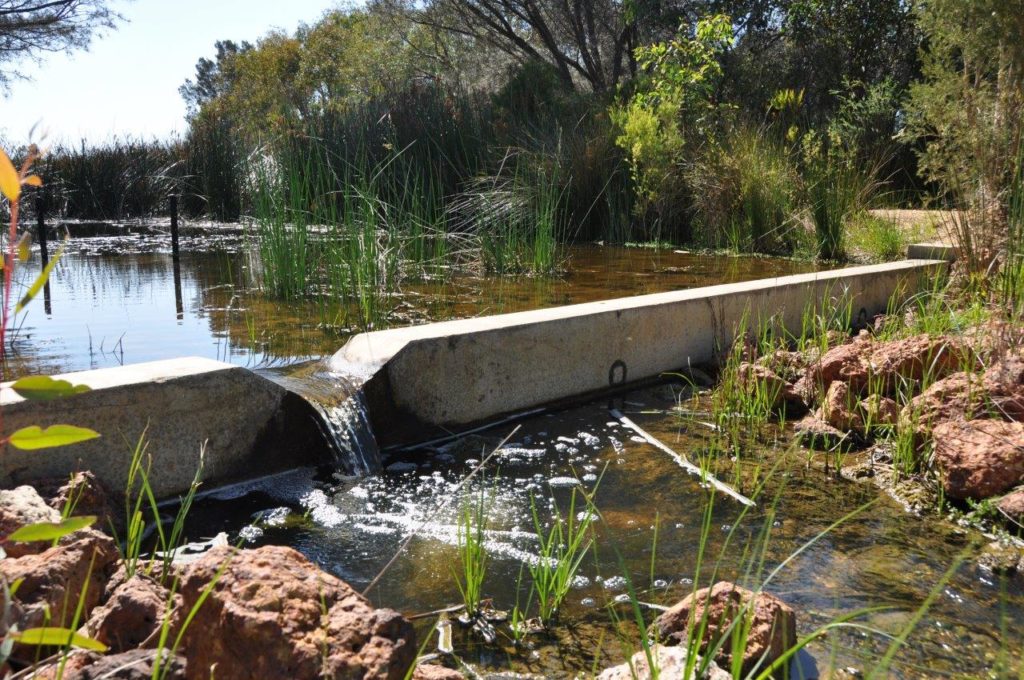
Project Details
The Wharf Street Wetland and Civic Centre Parklands intercept and treat stormwater (and groundwater) from the Wharf Street main drain, located in the greater Canning Plain Catchment - a priority catchment with high nutrient loads. The wetland was designed by Syrinx to remove nutrients and other pollutants from stormwater before it flows into the Canning River.
WSUD Category: Constructed wetland, Drainage for Liveability, Living stream, Retention of native vegetation, Swale / buffer strip
| Criteria | Information |
|---|---|
| Development Type: | Residential |
| Function/Driver: | Water quality |
| Government Area: | City of Canning |
| Site Context: | Shallow groundwater |
| Year Completed: | 2012 |
This project was a partnership between the Department of Parks and Wildlife and the City of Canning with support from the South East Regional Centre for Urban Landcare (SERCUL). The Wharf Street Wetland and Civic Centre Parklands intercept and treat stormwater (and groundwater) from the Wharf Street main drain, located in the greater Canning Plain Catchment – a priority catchment with high nutrient loads. The wetland was designed by Syrinx to remove nutrients and other pollutants from stormwater before it flows into the Canning River. High flows bypass the wetland and continue down the main drain so that scouring of the wetland during storm events does not occur. Discharge from the main drain and wetland enters the Canning River through rock cascades to encourage aeration and sediment removal.
Construction of the wetland involved the removal of a road and infrastructure that separated the City of Canning council offices from the Canning River Regional Park, restoration of 365 linear m of degraded foreshore and the establishment of a river access/ viewing node to control foreshore access. Seasonally saturated grassed areas were replaced with a functional wetland and useable grassed parkland (some of which is located on top of a subsurface flow wetland). A path network, shelter, BBQ, bins and seating were also installed to improve the active and passive recreational value of the site.
Revegetation of the site with 100,000 locally native plants of 37 different species has significantly improved the habitat value of the area, particularly for waterbirds and reptiles.
The wetland has been rigorously monitored using best practice methodologies to determine its performance and further understand how constructed wetlands perform on the Swan Coastal Plain. The wetland provides an excellent demonstration site for practitioners to witness first-hand a functional constructed wetland which improves habitat, amenity and importantly, water quality.
The one hectare wetland consists of surface and subsurface flow wetland components. The surface flow wetland components have been ‘online’ since late 2008, however, the subsurface flow components remained isolated due to the recycled concrete material (RCM) used in their construction. RCM was trialled in the wetland as it was an inexpensive, available, recycled material that was intended to provide an alkalinity boost to the system to encourage nutrient processing.
During installation the RCM was heavily abraded and also degraded over the ensuing years, resulting in an elevated alkalinity in the subsurface flow wetlands. Despite efforts to remediate, elevated levels of alkalinity persisted.
In June 2012, approximately 1500m³ of RCM was removed and replaced with a coarse laterite aggregate, with some of the material left in situ, realising the intended alkalinity benefits of the RCM. The laterite material has provided the added benefit of enhanced phosphorus removal in the subsurface flow wetlands.
The full case study New WAter Ways completed in collaboration with SERCUL and City of Canning, can be found here.
